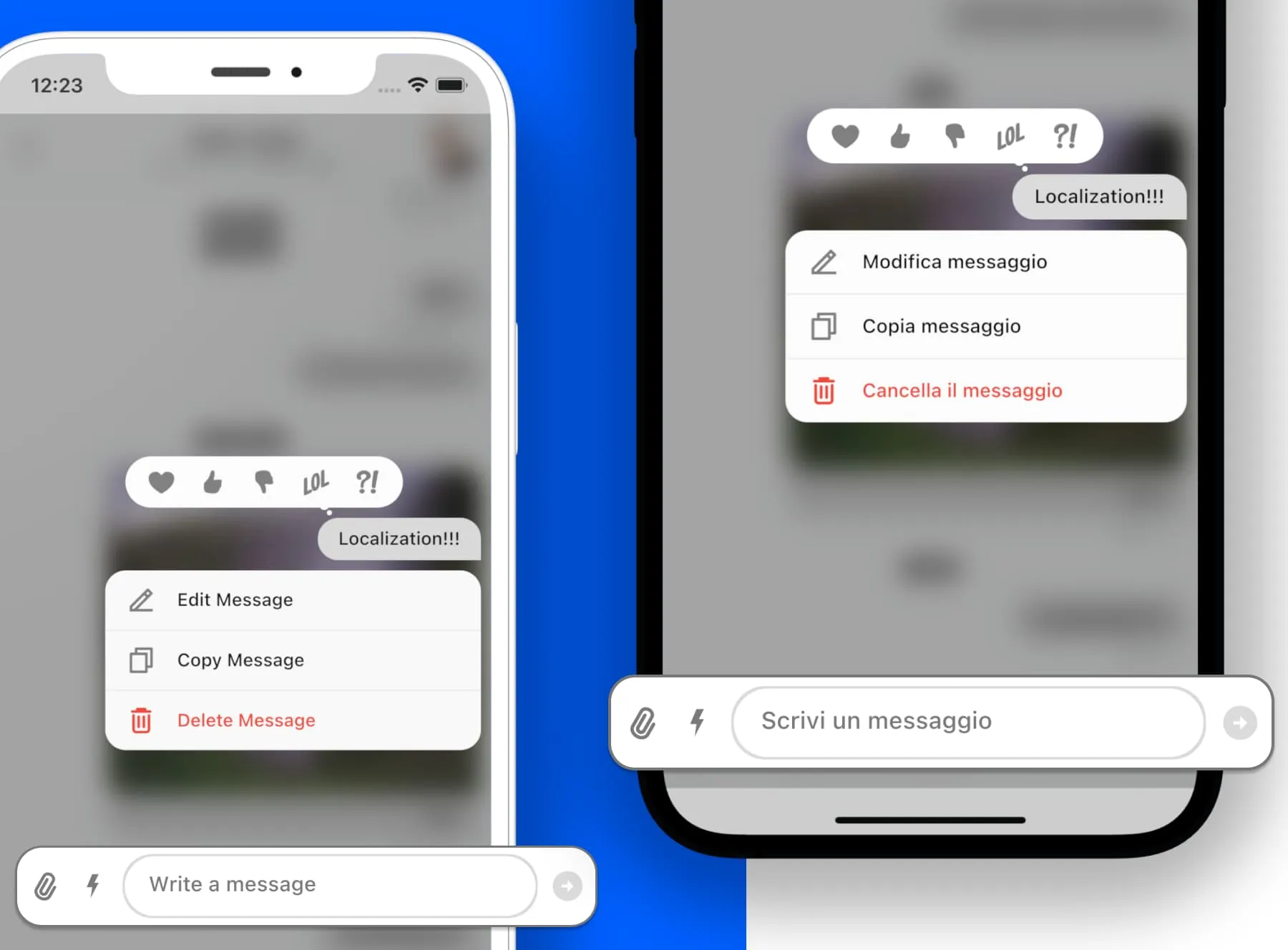dependencies:
stream_chat_localizations: ^latest_versionLocalization
Adding Localization (l10n) / Internationalization (i18n) To UI Widgets
Introduction
We have a dedicated package for adding localization to our UI widgets. It’s called stream_chat_localizations and you can find it here.

What is Localization?
If you deploy your app to users who speak another language, you’ll need to internationalize (localize) it. That means you need to write the app in a way that makes it possible to localize values like text and layouts for each language or locale that the app supports. For more information, see the Flutter documentation.
What this package allows you to do is to provide localized strings for the Stream chat widgets. For example, depending on the application locale, the Stream Chat widgets will display the appropriate language. The locale will be set automatically, based on system preferences, or you could set it programmatically in your app. The package supports several different languages, with more to be added. The package allows you to override any supported language or add a new language that isn’t supported.
If you want to translate messages, or enable automatic translation, please see the Translation documentation.
Supported languages
At the moment we support the following languages:
- English
- Hindi
- Italian
- French
- Spanish
- Japanese
- Korean
- Portuguese
- German
- Norwegian More languages will be added in the future. Feel free to contribute to add more languages.
Add dependency
Add this to your package’s pubspec.yaml file, use the latest version
Then run flutter packages get
Usage
Generally, Flutter and the Stream Chat SDK will use the system locale of the user’s device, if that locale is supported (see below). If the locale is not supported we will default to en (however it’s always possible to customize that).
Make sure to read more about localization in the official Flutter docs.
import 'package:flutter/material.dart';
import 'package:stream_chat_localizations/stream_chat_localizations.dart';
void main() {
WidgetsFlutterBinding.ensureInitialized();
runApp(MyApp());
}
class MyApp extends StatelessWidget {
// Setup client and channel code here
...
@override
Widget build(BuildContext context) {
return MaterialApp(
// Add all the supported locales
supportedLocales: const [
Locale('en'),
Locale('hi'),
Locale('fr'),
Locale('it'),
Locale('es'),
Locale('ja'),
Locale('ko'),
Locale('pt'),
Locale('de'),
Locale('no'),
],
// Add GlobalStreamChatLocalizations.delegates
localizationsDelegates: GlobalStreamChatLocalizations.delegates,
builder: (context, widget) => StreamChat(
client: client,
child: widget,
),
home: StreamChannel(
channel: channel,
child: const ChannelPage(),
),
);
}
}Setting a language
The application language can be changed through system preferences or programmatically.
System Preferences
The application locale can be changed by changing the language for your device or emulator within the device’s system preferences.
Note that the language needs to be supported in your application to work.
Programmatically
You can also set the locale programmatically in your Flutter application without changing the device’s language.
return MaterialApp(
...
locale: const Locale('fr'),
...
);There are many ways that this can be set for additional control. For information and examples, see this Stack Overflow post.
Adding a new language
To add a new language, create a new class extending GlobalStreamChatLocalizations and create a delegate for it, adding it to the delegates array.
Check out this example to see how to add a new language.
Override existing languages
To override an existing language, create a new class extending that particular language class and create a delegate for it, adding it to the delegates array.
Check out this example to see how to override an existing language.
Changing the default language
To change the default language you can use the MaterialApp.localeListResolutionCallback property.
Here is an example of how that would look like:
MaterialApp(
theme: ThemeData.light(),
darkTheme: ThemeData.dark(),
// Add all the supported locales
supportedLocales: const [
Locale('en'),
Locale('hi'),
Locale('fr'),
Locale('it'),
Locale('es'),
Locale('ja'),
Locale('ko'),
],
// locales are the locales of the device
// supportedLocales are the app supported locales
localeListResolutionCallback: (locales, supportedLocales) {
// We map the supported locales to language codes
// note that this is completely optional and this logic can be changed as you like
final supportedLanguageCodes =
supportedLocales.map((e) => e.languageCode);
if (locales != null) {
// we iterate over the locales and find the first one that is supported
for (final locale in locales) {
if (supportedLanguageCodes.contains(locale.languageCode)) {
return locale;
}
}
}
// if we didn't find a supported language, we return the Italian language
return const Locale('it');
},
// Add GlobalStreamChatLocalizations.delegates
localizationsDelegates: GlobalStreamChatLocalizations.delegates,
...
In this case, we’re using Italian as the default language.
⚠️ Note on iOS
For translation to work on iOS you need to add supported locales to
ios/Runner/Info.plist as described here.
Example:
<key>CFBundleLocalizations</key>
<array>
<string>en</string>
<string>hi</string>
<string>fr</string>
<string>it</string>
<string>es</string>
<string>ja</string>
<string>ko</string>
<string>pt</string>
<string>de</string>
<string>no</string>
</array>